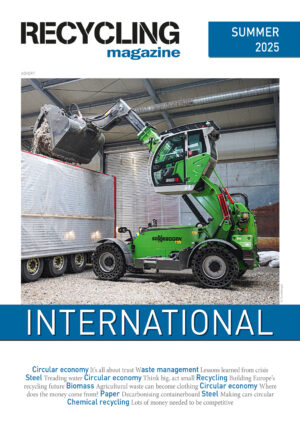Figures from worldsteel for the first six months of 2018 confirm an increase in global crude steel production of around 4.6% to 881.5 million tonnes compared with 842.4 million tonnes in the same period of 2017.
The data in our corresponding table show year-on-year crude steel production increases for China (+6% to 451.157 million tonnes), the EU-28 (+1.6% to 87.337 million tonnes), the USA (+2.9% to 41.849 million tonnes), Japan (+1.3% to 52.98 million tonnes), Russia (+3.2% to 36.264 million tonnes), the Republic of Korea (+3.7% to 36.066 million tonnes) and Turkey (+3.7% to 18.893 million tonnes).
Global crude steel capacity utilisation in June 2018 was 78.5% for an increase of 3.8 percentage points over the same month last year.
China increases steel scrap usage by 105%
In the first six months of 2018, there was a 105% surge in steel scrap usage for crude steel production in China to 127.6 million tonnes. This compares to 62.2 million tonnes in the same period of 2017 and underlines China’s position as the world’s largest steel scrap user.
The reason for this sharp increase is that the Chinese government has established stricter environmental quality standards and thereby higher pollutant emission standards for the steel industry. To meet these new thresholds and in order to avoid production restrictions, most BOF mills have actively increased their scrap input, with their steel scrap/crude steel ratio said to have been 20-25%.
In addition, many new EAFs are being installed or are in the pipeline for the near future. As a result, further investments in steel scrap processing are planned, especially in shredder capacity.
In the first six months of 2018, steel scrap usage for crude steel production also increased in the USA (+3.9% to 23.7 million tonnes), Japan (+3.6% to 18.493 million tonnes), Turkey (+4.9% to 15.882 million tonnes) and Russia (+11.1% to 11.398 million tonnes).
Steel scrap consumption in the EU-28 was almost unchanged (-0.3% to 47.964 million tonnes) whereas there was a pronounced decrease in steel scrap usage in the Republic of Korea (-3.2% to 14.973 million tonnes).
Further increase in Turkey’s overseas steel scrap purchases
The first half of 2018 brought year-on-year growth in Turkey’s overseas steel scrap purchases of 15.5% to 10.771 million tonnes, thereby underlining its position as the world’s foremost steel scrap importer. Over the same period, the Republic of Korea was the world’s second-largest steel scrap importer with a 7.4% increase to 3.262 million tonnes.
Also higher in the first half of 2018 were steel scrap imports into
- India (+11.2% to 2.864 million tonnes),
- Taiwan (+19.1% to 1.787 million tonnes),
- the EU-28 (+1.9% to 1.391 million tonnes),
- Canada (+156.6% to 1.219 million tonnes),
- Mexico (+15.1% to 1.119 million tonnes),
- Indonesia (+36.9% to 0.99 million tonnes),
- Thailand (+26.3% to 0.831 million tonnes); and
- Malaysia (+72.4% to 0.45 million tonnes).
In contrast, year-on-year import reductions were recorded by the USA (-1.3% to 2.468 million tonnes) and Belarus (-1.5% to 0.645 million tonnes).
EU-28 still the leading steel scrap exporter
The EU-28 remained the world’s leading steel scrap exporter in upping its outbound shipments in the first half of 2018 by 7% to 10.714 million tonnes, the main buyer being Turkey on 6.358 million tonnes (+5.6% year on year). The EU-28 also increased its overseas shipments to Egypt (+33.4% to 0.819 million tonnes), Pakistan (+12.4% to 0.807 million tonnes), India (+14.5% to 0.648 million tonnes), Switzerland (+4.1% to 0.281 million tonnes) and Bangladesh (+46.8% to 0.251 million tonnes). Conversely, a sharp drop was recorded in EU-28 deliveries to the USA (-27.2% to 0.474 million tonnes).
Statistics covering external steel scrap exports for the January-June 2018 period show the dominant position of the UK as the EU-28’s largest steel scrap exporter (-0.3% to 3.438 million tonnes).
The EU-28’s internal steel scrap exports totalled 15.005 million tonnes in the first half of 2018 (+0.4% when compared to the same period of 2017).
The first six months of 2018 brought a steep upturn in the USA’s overseas steel scrap shipments (+27.6% to 8.587 million tonnes). Among the leading buyers to extend their purchases from the USA were Turkey (+24.4% to 1.67 million tonnes), Mexico (+19.1% to 1.08 million tonnes), Taiwan (+25.2% to 0.983 million tonnes), India (+66.8% to 0.612 million tonnes), Canada (+25.9% to 0.578 million tonnes) and Vietnam (+35.9% to 0.413 million tonnes). Conversely, there was a decline in US scrap shipments to China (-14.7% to 0.46 million tonnes).
In the first half of 2018, an upturn was apparent in steel scrap exports from Russia (+28% to 2.75 million tonnes) and Canada (+16.2% to 2.487 million tonnes).
In contrast, there was a year-on-year decline in Japan’s overseas shipments of steel scrap (-5.4% to 3.781 million tonnes) despite a substantial increase in deliveries to the Republic of Korea (+7.6% to 2.168 million tonnes) and Vietnam (+12.8% to 0.721 million tonnes).
Drops in overseas scrap shipments were also recorded in the first six months of 2018 by Australia (-5.4% to 0.859 million tonnes) and Singapore (-10.5% to 0.368 million tonnes). Almost unchanged in the first half of the current year were steel scrap exports from Hong Kong (-0.3% to 0.642 million tonnes).











